Beyond North and South: NZ’s incredible forgotten ‘other islands’
By Andrew Bain
If you think of New Zealand as two islands, you’re vastly under quoting. The country consists of around 600 islands, many strewn far from the ‘mainland’ of the North and South islands. These islands off islands are often worlds of their own. Stray from the two major islands and you can find New Zealand’s most assured kiwi sightings, one of its most desirable wine regions, the world’s only island Dark Sky Sanctuary, the planet’s earliest sunrise, deep channels of history and absolute remoteness.
Stewart Island
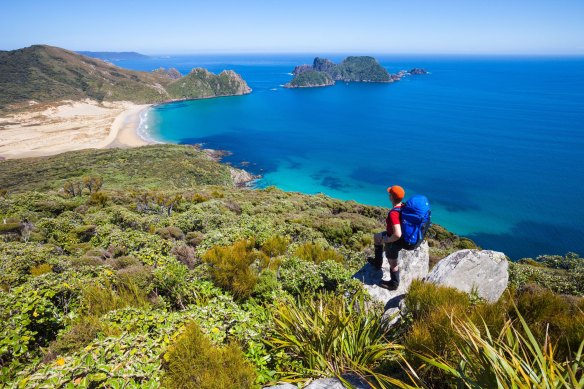
About 85 per cent of Stewart Island is part of Rakiura National Park.Credit: iStock
Often referred to as New Zealand’s third island, lonesome Stewart Island is a place where humanity is in the minority. About 85 per cent of the island is protected inside New Zealand’s newest national park, Rakiura, while brown kiwis outnumber Stewart Island’s 400 human Kiwis by about 50 to one. It’s the surest place in the country to nab a kiwi sighting, with nightly tours setting out from Oban, the island’s only settlement, to a secluded spit where kiwis appear most nights. Even the kiwi scenes for David Attenborough’s Life of Birds were filmed here.
With just 20 kilometres of sealed roads, Stewart Island is more a place for hiking than road tripping. The 32-kilometre, three-day Rakiura Track, looping out from Oban, is one of New Zealand’s 10 Great Walks, while even hardier souls brave the notorious mud on a 10-day circuit of the island’s north, taking in long Mason Bay and one of the southern hemisphere’s most extensive dune systems. For a shorter taste of the trails, take a day hike along the start of the Rakiura Track to Port William, returning by water taxi to Oban in the wide-winged company of albatrosses. See stewartisland.co.nz
Waiheke Island
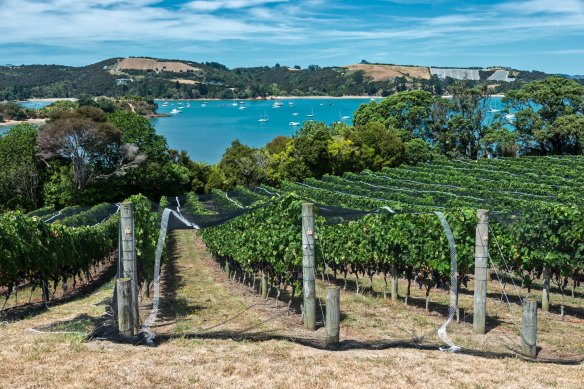
Waiheke is all about water and wine.Credit: iStock
Just a 40-minute ferry ride from central Auckland, local favourite Waiheke is all about water and wine. Clipped around its edges are radiant white-sand beaches such as Oneroa, Onetangi (Waiheke’s longest beach, almost two kilometres in length) and Palm Beach, but the more familiar image of this island of almost 10,000 residents is of vineyards, of which there are about 30. Plantings began in the late 1970s, with French red varieties mostly filling Waiheke wine glasses.
The largest vineyard on the island, Man O’War is also its only beachfront cellar door, allowing you to step straight from the bar to the beach on the namesake Man O’War Bay. Other cellar doors worth seeking out include Tantalus Estate, which is home also to a craft brewery, and Wild on Waiheke, where you can break up the tastings with a spot of archery and a laser claybird shoot.
Away from the vines, there’s zip lining, kayak tours, two mountain bike trail networks and 100 kilometres of walking trails. You can hike across the island in three hours on the Coast to Coast trail, or spend up to five days lapping Waiheke on Te Ara Hura.
Back among the vineyards, quality cellar-door restaurants include Poderi Crisci, Tantalus Estate and the Gaudi-inspired design of Casita Miro. See tourismwaiheke.co.nz
Great Barrier Island
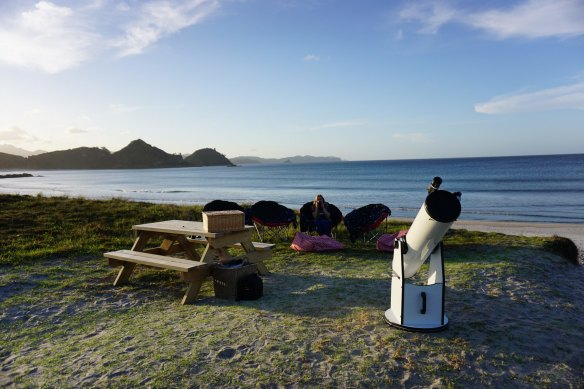
The world’s only Dark Sky Sanctuary island.Credit: Hilde Hoven
In New Zealand, Great Barrier isn’t a reef, it’s an island. The country’s sixth-largest island sits outside the mouth of Auckland’s Hauraki Gulf and combines beautiful beaches with hot springs, old logging dams and long walking tracks. Home to about 900 people, the island is entirely off-grid and while it doesn’t even have a supermarket, it does have New Zealand’s first off-grid brewery, Aotea Brewing, where beers come only from the taps since, in another sustainability measure, it doesn’t sell in bottles or cans.
Great Barrier is one of just 18 International Dark Sky Sanctuaries around the world (and the only island sanctuary), recognising the magnificence of the island’s night skies. Local operator Good Heavens runs stargazing tours, setting up a telescope atop a sand dune.
Hikers are drawn to the island for the multi-day Aotea Track, which runs through the central mountains, passing old kauri logging dams and the undeveloped and revitalising Kaitoke Hot Springs. The springs can also be reached on an easy one-hour walk.
Great Barrier Island is 90 kilometres north-east of Auckland, accessed on a 30-minute flight. See greatbarrierislandtourism.co.nz
Rangitoto Island
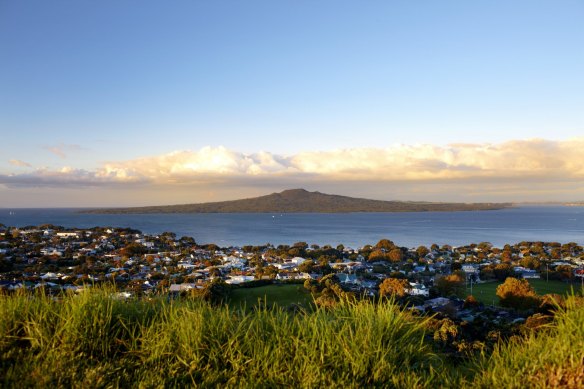
Rangitoto Island’s volcanic terrain, seen from Auckland.Credit: Chris McLennan
Just 10 kilometres across the water from Auckland’s city centre, Rangitoto is close enough to be a suburb, though it feels anything but suburban. Erupting from the sea less than 700 years ago, it’s the youngest and largest of the multitude of volcanic cones around New Zealand’s largest city. Most who are drawn to the island come to walk, with tracks passing lava caves and tunnels – bring a torch to explore – on the barren black slopes that lead up to the 259-metre summit of the classically conical island. Despite Rangitoto’s bleak appearance, it’s also home to the country’s largest forest of the red-flowering pohutukawas, also known as the New Zealand Christmas tree. See doc.govt.nz
Kapiti and Ulva Islands
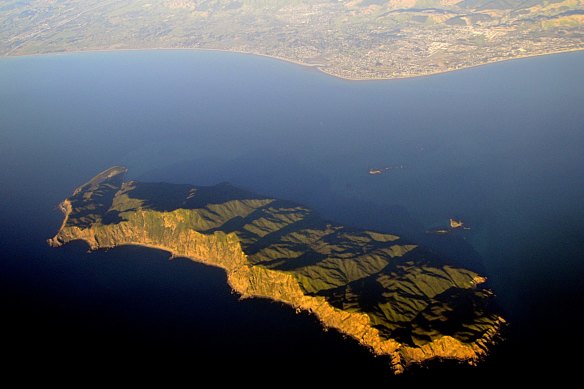
Kapiti Island, near Wellington, a native bird sanctuary.Credit: Getty
Though they’re half a country apart, these two small islands share a feathered legacy – predator-free for 25 years, they’re both important bird reserves easily reached by ferry. Offshore from Paraparaumu (North Island), Kapiti has several walking trails rich in birdlife. Climb to the island’s 521-metre high point, or loop through Rangitara to see the try pots (the vessels used to remove and render the oil from whale blubber) and other remains of its whaling past. Kapiti also has an option to stay a night among the birds, with cabins and a glamping tent on the island.
Native birds also abound at Ulva Island, inside Paterson Inlet on Stewart Island. Ulva has two walking circuits near its western tip – combine them for a three-hour wander among kakas and kererus. See doc.govt.nz
Urupukapuka Island
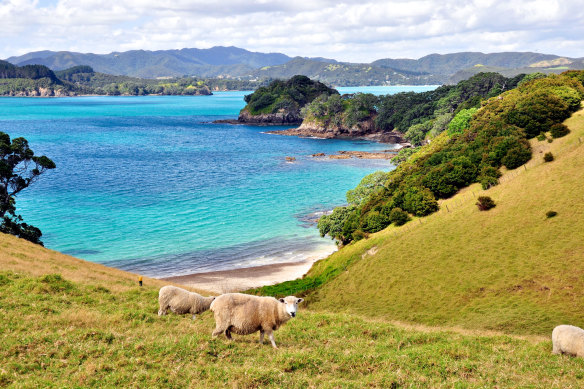
Of the Bay of Islands, Urupukapuka is the only accessible to visitors.Credit: iStock
The Bay of Islands, one of New Zealand’s hot-ticket tourist destinations, is cluttered with almost 150 islands, but only one – Urupukapuka, the largest island in the bay – is accessible to visitors. A 40-minute ferry ride from Paihia, the island is wrapped in beaches and replete with history. There were Maori settlements on Urupukapuka for hundreds of years before European arrival, and today there are 66 archaeological sites dotted around the island. Predator-free, the island has seen the reintroduction of several threatened bird species, and it’s ringed by a five-hour walking track that hops between archaeological sites, cliffs and beaches. The island also has three Department of Conservation campsites. See doc.govt.nz
Chatham Islands
The middle of nowhere is surely somewhere on the 10 scattered islands that make up the Chatham Islands, about 850 kilometres east of New Zealand. The first inhabited islands on Earth to see the sunrise each day, the Chathams receive only about 2000 visitors a year, which is half their appeal. Come to see the Giant’s Causeway-like basalt columns, and to climb monument-topped Mount Hakepa for a sunrise moment ahead of the rest of the archipelago. The Chathams are also a journey deep into history, with the islands home to descendants of the Moriori people, the first Polynesian settlers to arrive here more than 600 years ago. Ancient Moriori tree carvings at Hapupu are of such importance that they form one of only three national historic reserves in New Zealand. See chathamislands.co.nz
Sign up for the Traveller Deals newsletter
Get exclusive travel deals delivered straight to your inbox. Sign up now.